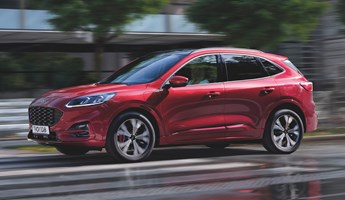
The start point for the best source of fleet information |
First drive: Ford Kuga
Date: 29 July 2020 | Author: Pete Tullin

|
|
||||||||||||||||||
Given the genre was pretty much invented in the US, it seems all the more baffling that Ford has taken so long to fully populate its European SUV line-up.
The obvious exception to this is the Kuga, which has been with us since 2008 and is about to enter its third iteration.
Along with fresh, handsome lines, this all-new Kuga is being offered with the company's latest petrol plug-in hybrid drive system, which employs a 2.5-litre four-cylinder petrol engine and a muscular electric motor, driving power to the front wheels via a CVT automatic gearbox.
A CVT might seem like an odd choice, as despite the inherent efficiency gains these types of transmissions do get a bad press due to the way they encourage the engine's revs to increase significantly quicker than the vehicle's road speed and continue to maintain a disproportioned amount of revs until you either reach your desired speed or ease off the accelerator pedal.
This said, Ford has managed to tune the Kuga's powertrain integration so well by using the electric motor's low-down torque to support the petrol engine, things rarely sound or feel stressed.
At low speeds, when driving purely in electric mode, the Kuga does suffer many of the same issues that blight most hybrids, namely notable electric motor whirr, especially when decelerating, and inconsistent brake pedal feel, as kinetic energy is harvested and fed back to the battery pack. To be fair, the Kuga's brake pedal feel is better than most, although overall stopping power could benefit from some additional bite.
The firm sports suspension fitted to ST-Line models also feels quite jittery at low speeds, and although the steering is super light to help take the strain out of the cut and thrust of town driving, it provides little notable connection to the front wheels.
That steering relationship does improve with speed, and because it is underpinned by the Focus platform it comes as no real surprise that the Kuga's ride and handling places it among the finest dynamic cars in the SUV sector. What's perhaps more revelatory is the exemplary low levels of road and wind noise, which combined with excellent high-speed comfort and reassuring stability make the Kuga a surprisingly accomplished long-distance touring vehicle.
Inside, the dashboard is largely unaltered from the Focus, complete with Sync touchscreen and a TFT instrument cluster ahead of the steering wheel, which changes theme and hue depending on the selected driving mode.
Most of the materials at eye level look and feel decent, but there are plenty of hard plastics the lower you look, and the big, slabby door panels are particularly uninspiring.
Thankfully, the Kuga scores higher on the practicality front. In the rear, there's a split-fold bench that slides back and forth, allowing you to choose between space for passengers or luggage, although it is worth noting that the centre pew is quite narrow and rather firm compared to the two outer seats. With the seats pushed fully rearward there's loads of legroom, and even in this configuration 411 litres of useful load-lugging space remains.
Of course, the jury is still out on plug-in hybrids in the business sector.
On paper their CO2 and fuel economy numbers are extremely impressive - the plug-in Kuga falls into a 1% BIK tax band, giving it a massive advantage over the 36% a 1.5 diesel auto version would attract.
Trouble is, hybrid fuel consumption figures rely heavily on a conservative driving style and religious adherence to plugging them in on a regular basis. In the real world, many drivers simply run around on petrol power alone with predictable results, although the Kuga's connected app does make it possible to monitor this behaviour.
You can typically recharge the Kuga's battery pack from empty in 3.5 hours using a 7.4kW home wall box, and once charged Ford claims it will run for 35 miles and up to 85mph without firing up the petrol engine. There are four bespoke settings for the electric drivetrain, which include EV Charge, which tops up the battery using the petrol engine, and EV Later, which holds the charge and is useful if your commute starts with a motorway run before entering city driving conditions. You can also boost the level of brake regeneration and associated braking power by prodding the L button on the rotary gear selector.
Overall then, the plug-in Kuga is a very compelling proposition. Low-speed hiccups and some questionable bits of cabin trim aside, it is a smooth, refined performer, offering excellent interior space and impressively low tax benefits.
Ford Kuga 2.5 PHEV ST-Line X
P11D: £36,930
Residual value: 45.6%
Depreciation: £20,080
Fuel: £5,118
Service, maintenance and repair: £2,724
Cost per mile: 46.5p
Fuel consumption: 201.8mpg
CO2 (BIK band): 32g/km (10%)
BIK 20/40% a month: £62/£123
Boot space: 411 litres
Engine size/power: 2,488cc/225hp
Verdict |
7/10 |
|||
 |
|
 |
|
|










